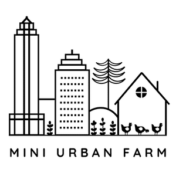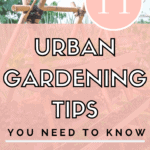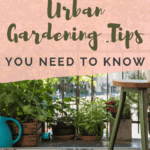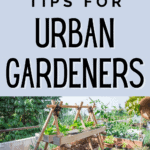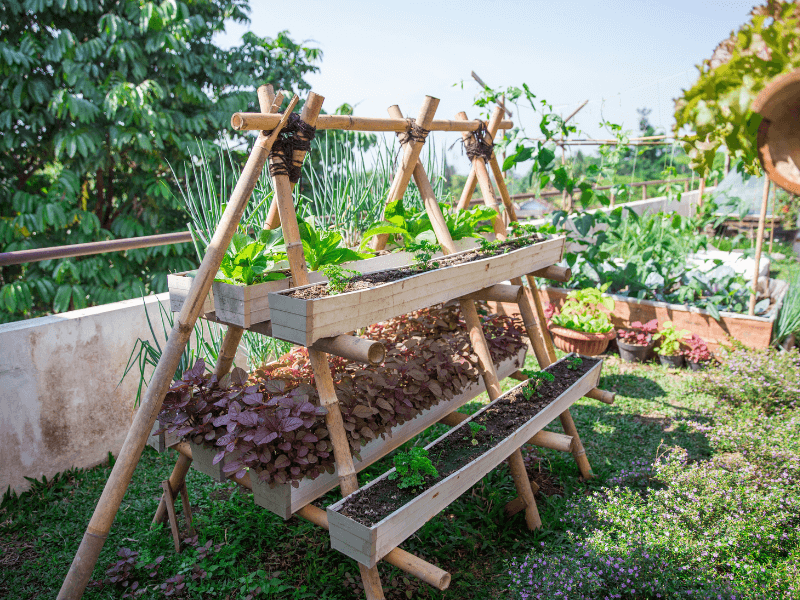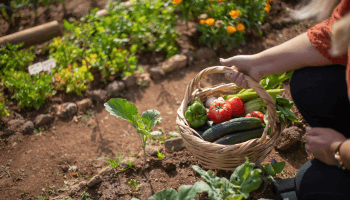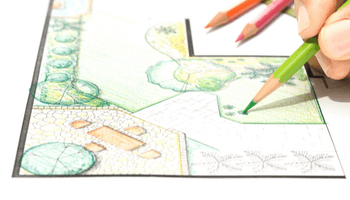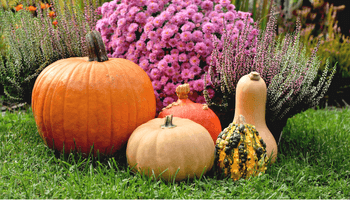Gardening can be hard work, and urban gardening definitely comes with its own set of challenges! Urban gardeners have more rules and regulations to deal with, less space to work with, and completely different conditions than other gardeners. So by using these urban gardening tips you can learn to maximize your space and get the most out of your urban garden!
Urban Gardening Tips You Need to Know
- Maximize space
- Know your pests
- Choose the right plants
- Know the rules
- Dual-purpose plants
- Practice kitchen composting
- Stick to minimalist gardening tools
- Use a mini greenhouse
- Set some goals
- Use square foot gardening
- Get creative
Disclosure: This post may contain affiliate links. If you purchase a product through one of our affiliate links we make a small commission from the sale at no extra cost to our readers.
Urban Gardening Tips
Think about a garden. What did you picture?
A small backyard with lots of plants and cute little pathways?
A concrete rooftop lined with containers growing vegetables?
Or even a small front yard producing as much food as a grocery store?
All of these are great examples of urban gardens. And definitely within reach for anyone looking to start a garden!
But in order to achieve that goal, you have to keep in mind a few urban gardening tips to have a successful gardening space!
1) Maximize your space
One of the major things to consider in an urban garden is the amount of space you have to work with.
Usually, urban gardening is on a smaller scale when compared to gardening in the countryside. Which means it’s important to use gardening techniques that will save you space!
One of the main ways I save space in my garden is by using trellises to grow vertically.
That in combination with container gardening, square foot gardening, and companion planting, helps me to maximize my space for my urban garden!
These gardening methods will allow you to plant more than double the plants and drastically improve your garden layout. Because of course we don’t have acres of space to dedicate to a garden!
Plus, combining techniques will help with pest and disease control too! Check out my Starting Your Urban Vegetable Garden workbook to see how I maximize my existing garden space!
2) Know your pests
Gardening in an urban or suburban area presents a unique challenge when it comes to pests.
Sure, you have the usual pests – things like ants, cutworms, aphids, etc.
But you won’t usually see things like rabbits and deer in the suburbs.
And while you won’t need to worry about those larger animals munching on your plants, you might need to squirrel-proof your garden or keep the racoons away!
The suburbs come with different critters and creep-crawlies than you would find elsewhere. So knowing what animals live in your area is a good start.
For example, we get a lot of small birds packing at the garden since there’s not a ton of hawks nearby to keep them away. And we’ve also seen several squirrels popping their head above the fence!
So knowing what things live around your area is a great way to critter proof your garden!
And knowing what beneficial insects don’t live around you will help you implement better pest control for the creepy-crawlies you don’t want in your space!
3) Choose the right plants
One of the best urban gardening tips I can give you is to choose the right plants.
This means several things.
Firstly, don’t choose plants that will get too big for your space.
The first year I planted zucchini I only had a small raised bed to work with. That would have been fine for one zucchini plant, but it definitely wasn’t okay for the 4 that I decided to plant!
I would have been much better off using that space for something more productive – and for something that wasn’t going to die from overcrowding in that small space!
Next, you might want to think about plants that don’t need help with pollination.
That’s because there may not be tons of pollinating insects like bees nearby to assist.
Which means less vegetables and fruits for you!
Some self-pollinating plants to grow include tomatoes, beans, eggplant, and peppers.
And by filling your garden with self-pollinating plants, you’ll get more of a harvest in case those beneficial insects don’t show up!
Psst…want to fast track your garden? Get access to my FREE gardening resource library and start maximizing your garden today!
4) Use Dual-purpose plants
By planting “dual purpose” plants, you’re able to save space and also be more discreet about your urban garden.
This will keep the neighbors happy, but also save you space to plant other things!
Take, for example, nasturtium flowers.
Not only are these plants beautiful, but the flowers are edible also!
So by planting out dual purpose plants, you’ll be landscaping and farming at the same time!
And you’d be amazed at how many plants produce edible flowers – or just look like landscaping!
You can plant rosemary as bushes and also use it for cooking.
Basil look nice as fill in plants, and is a fast-growing herb.
And zucchini plants produce beautiful yellow flowers, but you still get to eat the zucchini – and the flowers!
5) Know the rules
If you’re planning to start an urban garden, knowing the city, county, and community guidelines will save you a lot of headaches in the future.
For example, in my community we have an HOA.
The rules clearly state that we’re not allowed to plant any fruits or vegetables in ground.
That includes my lemon trees, my blueberry bushes, and my entire vegetable garden.
But since I looked up these regulations before I got started planting, I decided to build raised beds instead. So technically my vegetable garden is above ground, which is following the rules!
And if you’re not sure where to look, start with your home owner’s association if you have one. If not, the city ordinance office is a good place too!
6) Practice kitchen composting
Composing is an essential part of gardening, in my opinion.
Especially if you’re looking to garden on a budget!
But instead of creative huge, unsightly compost piles that the neighbors will complain about, start composting in your kitchen!
To get started, you can keep a small airtight container like this one right under your kitchen sink.
(It doesn’t really have to be airtight, but I don’t want to smell the compost whenever I open the cabinet!)
Whenever you’re cooking, take your compost-friendly kitchen scraps and put them in the container. Things like carrot tops, eggshells, and extra herbs are perfect!
Then when that container fills up, transfer everything into your outdoor compost bin, usually about once per week for me.
And if you want to watch my whole process, you can check out this video I made on kitchen composting!
7) Stick to minimalist gardening tools
In small space gardening, it’s important to only keep what you really need.
This goes for plants, seeds, and tools!
Now, I know it’s easy to get swept up in the latest and greatest gardening tool that you absolutely have to have – I’m guilty of this too!
But sticking to minimalist gardening tools will save you space, money, and headaches!
I usually stick to a few main tools – like a pair of good scissors, a hand trowel, and a pair of gloves. But try to limit yourself to the ones you use the most!
And overall you’ll probably find that you didn’t need that shiny new tool after all!
8) Use a mini greenhouse
In a larger garden, you might have an area for potting up your seeds, and area for keeping your gardening tools, and a large greenhouse to help prolong your gardening season.
In an urban garden, however, you probably don’t have room for all of those.
Which is why I like to use a mini greenhouse to start my seeds ahead of time and keep my plants safe in bad weather.
Now, do I really want a beautiful walk-in greenhouse with rows of terracotta pots and room for a cute little bench?
Of course – a girl can dream!
But in my urban gardening space, my mini greenhouse works perfectly!
In fact, the first season I used it to start my seeds, they germinated so much quicker and grew much better since they were protected from the elements!
9) Set some goals
In larger spaces, you have more flexibility to grow whatever you want and experiment.
If one plant doesn’t workout, just find an empty space and plant something else.
But in an urban garden, you’ll probably want to be more intentional in your garden set up.
That way, you’ll be able to meet your goals at the end of the season.
For example, one of my goals when I was first getting started was to grow at least half of the vegetables my family eats.
By knowing what those numbers were and intentionally planting out things we like to eat, I was able to make sure we met that goal!
And if you’re not sure what your gardening goals should be, check out this post on how to set gardening goals. Plus some sample goals to get you started!
10) Use square foot gardening
Square foot gardening is a great way to maximize your planting space since you get to calculate exactly how many plants you can fit in.
And if you’ve never heard of square foot gardening, it’s basically where you break up your gardening space – raised beds, in ground beds, containers, etc – into square foot plots.
And then you calculate how many of each type of plant can fit into one square foot.
For example, only one tomato plant can fit into one square foot, but you can fit 9 bean plants into that same space.
So by using this method in your own urban garden, you can choose plants that have a high yield in a small space!
11) Get creative
Gardening in small spaces requires a lot of creativity and flexibility!
Especially if you’re growing an urban vegetable garden and want to get the most food out of your space.
So by combining all of these urban gardening tips above, and staying flexible in the process, you’ll be able to create a highly productive space!
For example, one of the main ways I’ve been creative in my own garden is by using trellises around my raised beds.
My trellises go up the sides of my beds, and then run over the entire bed.
That way my vegetables can trellis from anywhere in the bed, even straight up from the middle!
And if that doesn’t make sense, you can see exactly how I built my raised bed trellises in this video.
What plants are best for urban gardens?
Every urban garden is different depending on the space you have, the type of plants you want to grow, and where you live.
But generally the best type of plants for an urban garden are ones that take up little space and produce a high yield.
Plants that can grow in containers are also ideal for an urban garden since you can keep them on patios, balconies, and small spaces.
And by using these space saving urban gardening tips, you can maximize your gardening space to accommodate everything you want to plant.
For example, in my small urban garden I am able to grow all the vegetables my family eats! Including zucchini, butternut squash, and even corn!
How do you grow the most food in a small space?
Vertical gardening, square foot gardening, and companion planting are my go-to methods for growing tons of food in a small space!
These techniques allow you to maximize the airspace instead of ground space, combine more plants in a small area, and calculate exactly how much food you can grow!
How do I start an urban garden?
The first step to starting an urban garden is to know the rules and regulations in your area.
Once you know that, find a space you can dedicate to your garden and create a layout for your urban garden.
This is an important step since not all plants can survive under all conditions!
And some plants do much better when planted near other plants.
Next, choose the plants you want to grow and add those to your garden layout.
Once you have all that mapped out, set up your gardening space and get planting!
Hopefully these urban gardening tips will help you have a productive and beautiful urban garden! Combine them all together for optimal results in the least amount of time!
I hope this was super helpful! And for more gardening resources, get access to our free gardening resource library! It will help you fast track your garden and it only takes 5 seconds!
Pin Urban Gardening Tips for later!


